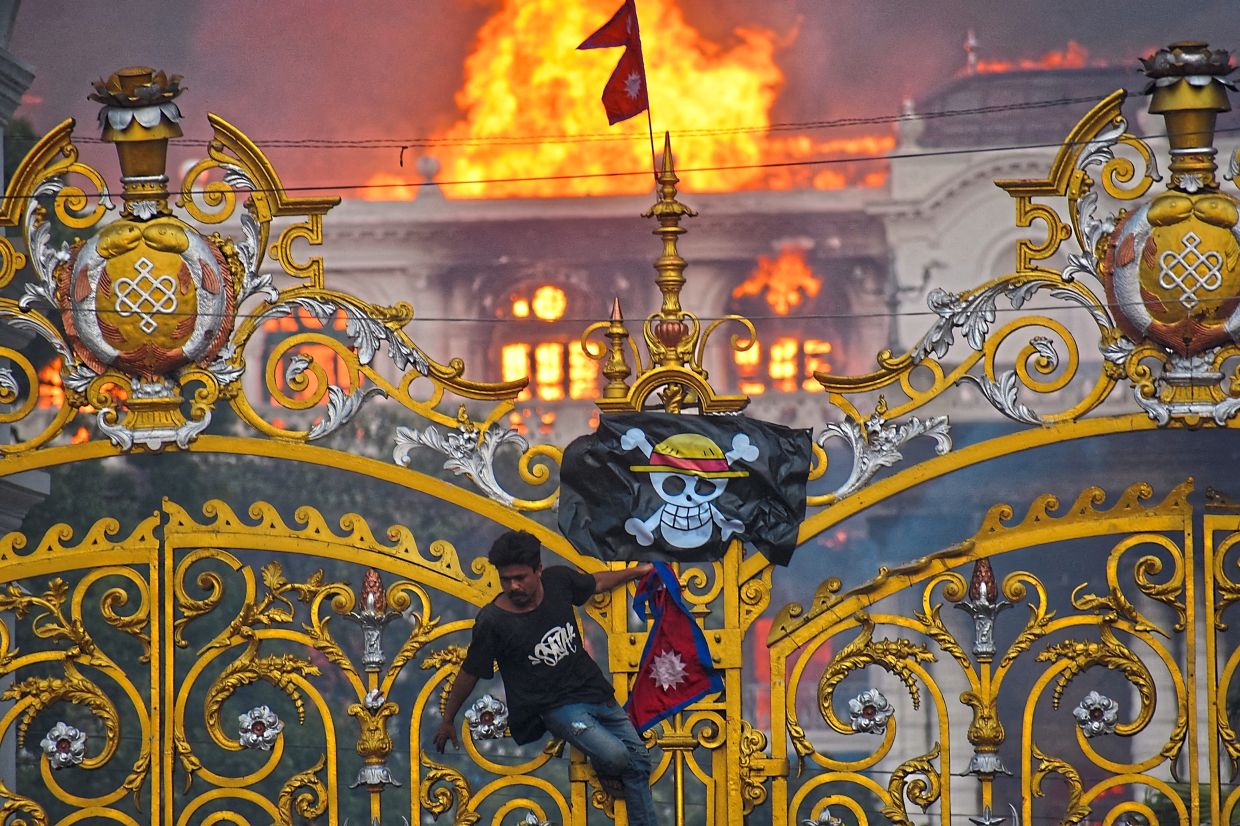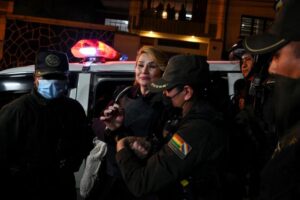AHOY and move over, Che Guevara, today’s unlikely protest icon is not a beret-wearing revolutionary but a grinning anime pirate flag.
Keen-eyed observers have been spotting a curious banner at demonstrations everywhere from Rome to the Philippines. Earlier in September in Kathmandu, as public anger erupted, the flag became the defining image while flames engulfed the gates of Singha Durbar, the nation’s ornate seat of power.
Defined by hollow cheeks, a toothy smile and a red-banded straw hat, the symbol has been lifted high by youth-led protests for change. It has rattled governments, too. Indonesia has branded its use “treason” and “propaganda to disunite the country”.
One Piece, created by manga artist Eiichiro Oda, is a Japanese manga and anime phenomenon launched in 1997 that has since sold over half a billion copies worldwide. At its heart is Monkey D. Luffy, a straw-hat-wearing pirate who, alongside his motley crew, sails in search of freedom and adventure while confronting a corrupt, authoritarian World Government.
Spanning more than 1,000 television episodes, multiple films, and a Netflix live-action adaptation (plus its own Lego theme), One Piece has become a cultural giant. Its titular flag of the Straw Hat Pirates’ Jolly Roger, first hoisted on their beloved ship the Going Merry, is instantly recognisable to millions across the world.
The rise of the Straw Hat flag is the latest 21st-century example of pop culture fuelling protests. In Thailand and Myanmar, the three-finger salute from The Hunger Games movies became a potent symbol of resistance to military rule. In South Korea, people protesting martial law waved K-pop light sticks usually seen at concerts, blending fandom with activism in vivid defiance.
The recent growing protests across South-East Asia, meanwhile, are rooted in deep national grievances. In Indonesia in August, anger erupted over corruption, inequality, and government policies. In the Philippines, frustration centred on allegations that officials siphoned off funds meant for critical flood relief.
To fans, the One Piece banner represents grit and rebellion. Luffy’s superhuman elasticity, gained from eating the mystical gum-gum fruit, is a vivid metaphor for endurance, while his relentless pursuit of freedom against impossible odds resonates with young people confronting corruption, inequality, and heavy-handed rule.
By adopting the Straw Hat flag, protesters are not merely borrowing a pop culture image but tapping into a story legible to millions. First seen at pro-Palestinian rallies everywhere from Indonesia to New York, it only took on real political life in Indonesia, where a large fan base of the anime and strong sense of community already existed.
The lightning-fast spread of the flag reflects Gen Z’s digital roots. This is the first generation raised entirely online, steeped in memes, anime, and global entertainment. Their political engagement forms what scholars call “networked publics”, where communities mobilise and communicate through digital platforms instead of association through traditional organisations.
Solidarity in these environments needs no party membership or ideology but instead rests on shared cultural cues. A meme, gesture, or flag accelerated by social media can transcend barriers of language and geography, creating a common ground that allows young people to recognise one another even under very different political systems.
For me, the effectiveness of this lies in how it encourages participatory action. Symbols drawn from pop culture invite people not only to identify but to join in remixing, sharing, and adapting them. When young people can see their own creativity reflected in protest symbols, it fosters a deeper commitment to collective causes and a willingness to take action beyond social media.
Crucially, this was not mere imitation. Much like the story of One Piece itself, where the Straw Hat crew sails from island to island toppling tyrants and freeing the oppressed, each country’s protesters adapted the flag to their own struggles, yet its meaning of defiance and liberation remained instantly recognisable elsewhere.
Rooted in pop culture rather than party politics, the flag resists suppression. Government crackdowns risk appearing heavy-handed; when Indonesian authorities confiscated banners and branded them treasonous, they only amplified the flag’s appeal as well as public anger.
This convergence of fandom and activism signals a wider shift in protest culture. In the past it was tactics such as hunger strikes or boycotts that travelled across borders. Now, it is symbols and cultural references in the forms of flags, memes, and salutes that move fastest.
I hope this trend signals a shared, global political imagination among the young, one that transcends old left-right binaries. It need not rely solely on memes or pop culture but should channel the same creativity and cross-border solidarity into building institutions, ideas, and movements to confront climate change, inequality, and authoritarianism.
If One Piece teaches anything, it’s that freedom demands persistence and alliances. Today’s youth movements echo that spirit of charting new waters, challenging entrenched power, and imagining futures beyond corruption and authoritarianism. Like Luffy’s crew forging alliances across the seas, these protests draw strength from transnational solidarity.
And the lesson for governments?
Cartoon flags or anything rooted in pop culture may seem trivial, but silencing these gestures risks magnifying the grievances fuelling them.
In an age where culture and politics are inseparable, young people have built an emotional universe of their own where entertainment and activism has merged into a new form of collective action.
Jonathan Lee Rong Sheng traces his writing roots to The Star’s BRATs programme. He is now a Malaysian youth advocate. The views expressed here are solely the writer’s own.







